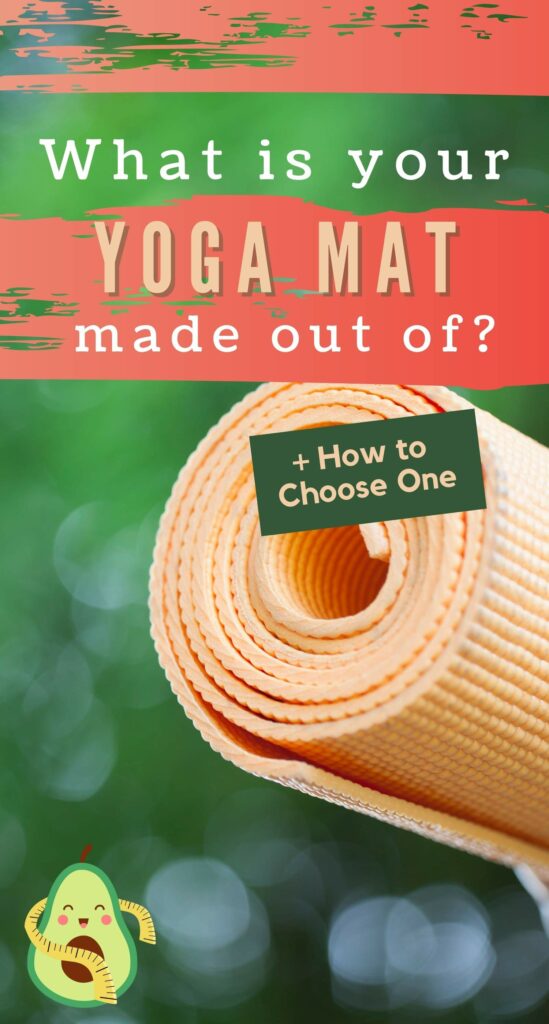4 Best Healthy and Eco Friendly Yoga Mats + How to Choose One
It’s easy to forget just how many of our normal, everyday belongings are bad for us, or bad for the environment.
And then you see a special on TV or a post on social media about the trash in the ocean, or about plastic causing cancer, and you commit to going all-natural for good!
You buy the bamboo straws. Trade in your plastic baggies for glass containers. Decide to try something crazy like beeswax food wraps (which, by the way, are actually pretty cool).
And then a month goes by, and one day you look down at your hand only to realize with horror that you’re holding a disposable Starbucks cup!
Or your newest purchase arrives in a smiling brown box, and inside that cardboard, it’s covered in plastic wrap. Anyone else have a bad Amazon prime habit?
Plastics and disposables are a very ingrained part of our world, and I’m sure you’re just as frustrated as I am with trying to live a greener lifestyle — especially in a way that is also affordable.
But does this mean we should stop trying to keep ourselves and our planet healthy?
Heck no!

There might not be a perfect solution, but I’ve learned that the best thing we can do is be conscious consumers, and put some thought into the purchases we make.
A great place to start is with your yoga mat, especially if you practice regularly (or are planning to). Because while the issue of recyclable materials in your yoga mat might be obvious, the fact that they may also be toxic is not so obvious to most.
WARNING: There is a good chance you have some very dangerous things lurking in your yoga mat! More on that in a moment.
I’ve done some research, and narrowed down my recommendations to the top four eco-friendly yoga mats that are healthy for you AND won’t end up lingering in a landfill for a thousand plus years.
So you can feel good about your practice and its impacts on the environment.
Different people need different things from their yoga mat regarding cushion, sticky support etc., so I’ll tell you what to look for when you’re shopping. But first, let’s talk about the one thing you should avoid at all costs when it comes to choosing a yoga mat.
This post may contain affiliate links, which helps keep this content free. Please read our disclosure for more info.
Is Your Yoga Mat Making You Sick?

For decades, the iconic “sticky mat” has been the most popular yoga mat around.
It’s cushiony, it provides just enough stickiness to give you traction during your routine, it’s easy to clean, compact and lightweight.
The problem? It’s made out of PVC (polyvinyl chloride) – a super toxic plastic made with ingredients like BPA, dioxins, and phthalates that are known cancer causers and endocrine disruptors.
These harmful agents can enter your body through your skin when you touch your mat, and through your lungs when you breathe around it (especially if you add heat, like in hot yoga or outdoor yoga).
Plus, these popular yoga mats aren’t easily recycled and never biodegrade; but they do leach those same toxic chemicals into the air, earth, and water around them as they break down into smaller particles—polluting everything around them for generations to come. (1)

This yucky material is toxic during it’s entire life cycle—from creation to use to disposal. (2)
So no matter how much you love your old yoga mat, it’s time to get rid of it and find a healthier, more eco-friendly alternative!

Man-Made Materials
Man-made materials are the trickiest to figure out when you’re shopping.
It isn’t immediately obvious what components are in them—kind of like the difference between the produce isle and the snack foods isle at the grocery store.
Only, there isn’t a handy ingredients list on the label to make sure you can pronounce what you’re buying.
Luckily, other people have figured this out—and just like snack foods, you might be surprised at what your favorite things are made of.
PER – The Eco-PVC

There are a few companies advertising a “safer” alternative to PVC, which they’re calling “eco-PVC.”
It’s also called PER (polymer environmental resin), and it is less toxic to manufacture and recycle than PVC.
PER is still a type of plastic, but it is free of phthalates, BPA, and dioxins.
It is becoming increasingly popular for yoga mats, since it adds the durability, padding, and flexibility you need in a great yoga mat, and is biodegradable. (3)
If you want to try out a PER yoga mat, Natural Fitness Warrior makes a great one with a blend of PER and natural rubber.
It’s inexpensive and durable, and the PER keeps it from having that natural rubber odor.
You can check it out here.
TPE – The New Standby

TPE (thermoplastic elastomer) has become the new go-to as a PVC alternative for yoga mats; but what is it, really?
Well, we know that it is usually a mixture of plastic and rubber—and that’s about the extent of our knowledge. (4)
Manufacturers aren’t required to tell you exactly what TPE is made out of. (Seriously!)
So while it is BPA and phthalate free, it could still contain other toxins. We really don’t know. (5)
The good news is that TPEs are recyclable and can be remolded, and it takes less energy to produce than other materials. (6)
If you’re looking for something similar to your old PVC mat, TPE mats are probably the closest match, since they are lightweight, flexible, durable, and come in every color of the rainbow.
Gruper has some cute ones with customizable color, size, and thickness. You can even get one with your zodiac sign on it!
Click here to check them out.
Natural Materials
I can’t imagine anything better to sit on while you search for inner peace and harmony than something totally natural that doesn’t harm the environment at any point in its lifecycle.
(Sorry, Karen with the essential oils—but I couldn’t find any made with lavender or crystals, so you’ll have to add those yourself!)
There are a lot of “natural” yoga mats out there—including ones made of jute, cork, cotton, and rubber.
If you’re currently cringing at the idea of doing cobra pose on a burlap sack, fear not—we found some very comfortable, and very cute options (not that jute mats are bad—they just weren’t our favorite picks!).
After looking at all the natural options, here are our two faves!
Cork – Saving the World One Tree at a Time

The coolest part is that to harvest the cork, workers just strip the thick bark from the cork tree—without cutting it down!
It doesn’t harm the tree, it provides fair-trade jobs to rural areas, and cork forests even provide habitat for endangered animal species. (7, 8)
And since it’s a totally natural material, it easily biodegrades.
But does it make a good yoga mat?
The answer is yes—but not by itself.
Cork is waterproof and naturally antimicrobial, so you don’t have to worry about funky odors or bacteria on your mat. (7, 9)
It is durable and springy, plus it’s lightweight.
However, cork mats usually have a rubber or synthetic bottom layer—and you won’t find a 100% cork yoga mat.
Still, you’ll be reducing your carbon footprint and supporting a sustainable industry, while getting a really awesome yoga mat.
We love Yoloha’s cork mats, since they have several options based on your needs, and they use eco-friendly backing materials.
Plus, Yoloha makes a huge effort not to use any plastic ever in their products, and your cork mat will be shipped in recycled cardboard and paper.
Rubber – Smelly, yet Satisfying

While rubber yoga mats do have a strong rubber smell and are heavier than other mats, they provide great grip, padding, and durability.
Natural rubber is harvested by tapping rubber trees and collecting the liquid latex that drips out, the same way that maple syrup is harvested from maple trees. (10)
This doesn’t hurt the tree, and it provides fair-trade jobs to people in rural areas.
It is then heated and mixed with additives to improve strength, elasticity, and etc.
That’s where you need to be careful, and make sure your rubber mat doesn’t contain cancer-causing bisphenols (BPA being the worst one), or petroleum-based additives. (11)
Most natural rubber yoga mats are made to be non-toxic and free of harmful ingredients, although you should obviously avoid rubber mats all-together if you have a latex allergy.
And when you’re done with your mat, rubber is easily recyclable, often being made into things like playground flooring, surgical gloves, and even welcome mats. (11)
If you’d like to try a rubber mat, Jade Yoga makes several different options to meet your needs.
Plus, their mats are made in the USA, and they plant a tree for every mat sold!
You can check out Jade Yoga mats here.
The bottom line: There are a lot of eco-friendly yoga mat options available, and any choice you make will be healthier than a PVC mat.
So remember to have fun, and pick a mat that will make you excited to practice yoga every day!
Yoga for a Healthier You
So now that you have a beautiful, healthy new yoga mat, you’re probably searching for the right yoga routine.
If you want to lose weight, gain flexibility and strength, and relieve your aches and pains with a gentle yoga practice, our Yoga Fat Loss Bible is for you.

We provide detailed instructions and beginner modifications for your practice + a 6-Week Workout Plan any beginner can start with!
It also comes with a free meditation guide for beginners that will help you let go of your worries and relieve stress and anxiety.
Click here to start your yoga fat loss journey today!
Always remember that the most difficult part of doing any new workout routine is SHOWING UP.
Make sure to show up today and give your best to your yoga practice. You deserve it!
If you enjoyed this article on eco-friendly yoga mats or have any questions for us, please leave them in the comment section below!
